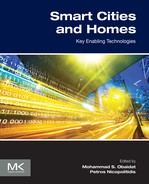Cars as a main ICT resource of smart cities
Abstract
Inter-Vehicle Communication (IVC) is expected to play a central role in tomorrow’s smart cities. Yet, even today, operators of infrastructure are struggling to keep up with the increasing data demand and infrastructure might not be available in more extreme conditions, such as natural or man-made disaster situations. We see a way out in the use of cars as a main Information and Communication Technology (ICT) resource of smart cities, in a technology agnostic architecture that we term Car4ICT. Cars can be envisioned to be available almost ubiquitously in future smart cities and are flexibly made use of to mediate between users offering and consuming services. We present a flexible and extensible scheme for service discovery, as well as how to set up and operate such an architecture. To illustrate the feasibility of the Car4ICT architecture, we conclude with an evaluation of the service discovery performance in our Car4ICT framework under progressively worsening conditions. This evaluation is based on a custom-built Open Source simulation framework for evaluating such complex systems using multiple communication technologies in a heterogeneous vehicular network. We show that even in such conditions simple tweaks to protocol parameters can deliver good user experience in terms of low service discovery latencies.
Keywords
1. Introduction



2. Related work
3. The Car4ICT concept
3.1. Use cases
3.2. Basic architecture


3.3. Service and neighbor tables
Table 7.1
A Service Table Example
| User | Hash Tag | Metadata | ||
| 1 | hash(file1) | location = Tokyo | type = video | size = 2 GB |
| 3 | hash(file1) | location = Tokyo | type = video | size = 2 GB |
| 7 | hash(file1) | location = Paderborn | type = video | size = 2 GB |
| 1 | hash(file2) | location = Tokyo | type = image | |
| 12 | hash(file2) | location = Tokyo | type = image | size = 500 MB |
| 7 | CPU | location = Paderborn | type = ARM | |
| 7 | Storage | location = Paderborn | type = hours | size = 78 GB |

4. Simulative performance evaluation

Note that both scales are logarithmic [6]


No reached car knows how to match requester and provider (big dots)

Shown is an example path from provider to requester
5. Simulation study
Table 7.2
Used Simulation Parameters
| Parameter | Value |
| Simulated area | 0.7 km2 |
| Average number of equipped cars per square kilometer | 35–415 |
| Total number of users | 15 |
| Number of users requesting | 5 |
| Number of users offering | 5 |
| IVC technology | IEEE 802.11p |
| IVC maximal transmit power | 10 mW |
| Simulation duration | 80 s |
| Service table broadcast interval | 0.1–10 s |
| Neighbor table entry lifetime | 10 s |
| Service table entry lifetime | 10 s |
| User request interval | 2 s |
| Request time-out | 30 s |
IVC, Inter-Vehicle Communication.

The service table broadcast interval was set to 10 s. The inset shows a zoom to the first 5 s

The traffic density was 35 vehicles/km2
